- 19 MAI
- SYRIE – 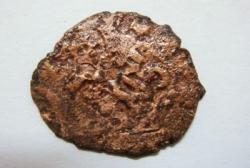 Shmaemis, al-Andarin , Qeb al-Hat - Hama Antiquities Department finished the restoration of a group of rare antique coins dating back to Byzantine and Islamic Eras. The coins were unearthed during the excavation works at the archaeological sites of Shmaemis, al-Andarin and Qeb al-Hat. Director of Hama Antiquities Department Abdul Qader Farzat said that this group includes 25 pieces of coins which were restored in several stages by using special techniques like the Mekerator tool and the preservatives to show the art forms portrayed on these coins. Farzat added that the coins are rich with graphics of the leaders, gods and emperors of those periods, in addition to ancient Arab and Roman inscriptions which give important information about the history of those societies, their economy and activities. He pointed out that his Department has set up a study for the restoration of the 10-ton basalt lion statute which is now showcased at Hama Museum.
Shmaemis, al-Andarin , Qeb al-Hat - Hama Antiquities Department finished the restoration of a group of rare antique coins dating back to Byzantine and Islamic Eras. The coins were unearthed during the excavation works at the archaeological sites of Shmaemis, al-Andarin and Qeb al-Hat. Director of Hama Antiquities Department Abdul Qader Farzat said that this group includes 25 pieces of coins which were restored in several stages by using special techniques like the Mekerator tool and the preservatives to show the art forms portrayed on these coins. Farzat added that the coins are rich with graphics of the leaders, gods and emperors of those periods, in addition to ancient Arab and Roman inscriptions which give important information about the history of those societies, their economy and activities. He pointed out that his Department has set up a study for the restoration of the 10-ton basalt lion statute which is now showcased at Hama Museum.
http://www.english.globalarabnetwork.com/2011051810951/Culture/archaeologists-restoration-of-rare-byzantine-coins-in-syria.html
- AUSTRALIE – Condobolin - Heavy rainfall earlier this year has helped to uncover an Aboriginal burial site. An Aboriginal burial site near Condobolin could be more than 25 thousand years old. The remains of an aboriginal man were found on a private property, around 50 kilometres from the town earlier this year. An archaeologist with the New South Wales Office of Environment and Heritage Phil Purcell says the fossilisation of the bones dates them as being around 10 thousand years old. However he says the location of the grave, near the former watercourse of the Lachlan River, suggests the find could be even older. "Scientists had previously dated part of these ancient watercourses to 25 thousand years ago, when that part of the Lachlan River, now extinct, was flourishing with water," Mr Purcell said. "Who knows, it's buried right next to a very watered area which 25 thousand years ago was very well watered so we could be looking at around about that time period, maybe even older." The New South Wales Office of Environment and Heritage is now working with the local indigenous community to preserve the rare find with the possibility or relocation.
http://www.abc.net.au/local/stories/2011/05/19/3220917.htm
- FRANCE – 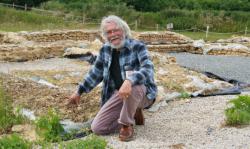 Le Quiou - Le site archéologique du Quiou, au sud de Dinan, est le seul partenaire costarmoricain des journées nationales de l'archéologie, organisées samedi et dimanche. L'initiative prise par le ministère de la Culture est coordonnée par l'Inrap qui dirige les fouilles du Quiou depuis l'année 2000. Le conseil général, propriétaire des parcelles, est partenaire de l'opération. Les visiteurs pourront donc parcourir ces archives du sol qui laissent apparaître une grande ferme gallo-romaine du Ier siècle. Les fouilles archéologiques ont révélé des vestiges qui permettent de déterminer une occupation régulière de l'établissement jusqu'au XIIesiècle. C'est la plus grande villa connue de cette époque en Bretagne. En tout, 2ha de bâtiments. Chaque été, les fouilles bénévoles, encadrées par l'Inrap, permettent de mettre au jour de nouvelles données. En 2011, ce sont les appartements privés du propriétaire gaulois de la villa qui vont être découverts.
Le Quiou - Le site archéologique du Quiou, au sud de Dinan, est le seul partenaire costarmoricain des journées nationales de l'archéologie, organisées samedi et dimanche. L'initiative prise par le ministère de la Culture est coordonnée par l'Inrap qui dirige les fouilles du Quiou depuis l'année 2000. Le conseil général, propriétaire des parcelles, est partenaire de l'opération. Les visiteurs pourront donc parcourir ces archives du sol qui laissent apparaître une grande ferme gallo-romaine du Ier siècle. Les fouilles archéologiques ont révélé des vestiges qui permettent de déterminer une occupation régulière de l'établissement jusqu'au XIIesiècle. C'est la plus grande villa connue de cette époque en Bretagne. En tout, 2ha de bâtiments. Chaque été, les fouilles bénévoles, encadrées par l'Inrap, permettent de mettre au jour de nouvelles données. En 2011, ce sont les appartements privés du propriétaire gaulois de la villa qui vont être découverts.
http://www.letelegramme.com/ig/generales/regions/cotesarmor/villa-du-quiou-visites-guidees-du-site-dimanche-19-05-2011-1305956.php#
- FRANCE – 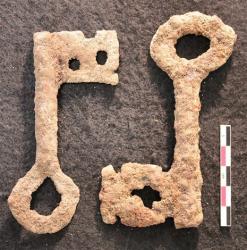 Argentan - L’institut national de recherches archéologiques préventives (Inrap) a procédé à des fouilles à Argentan, à l’occasion d’un chantier pour un vaste lotissement sur le quartier rural de Coulandon. Elles ont permis de découvrir un nombre important de structures d’habitat datant du IXe et du Xe siècle. Une nécropole intacte, contenant 25 squelettes parfaitement conservés a également été mise au jour. Ce qui en fait les traces les plus anciennes d’habitat structuré à Argentan.
Argentan - L’institut national de recherches archéologiques préventives (Inrap) a procédé à des fouilles à Argentan, à l’occasion d’un chantier pour un vaste lotissement sur le quartier rural de Coulandon. Elles ont permis de découvrir un nombre important de structures d’habitat datant du IXe et du Xe siècle. Une nécropole intacte, contenant 25 squelettes parfaitement conservés a également été mise au jour. Ce qui en fait les traces les plus anciennes d’habitat structuré à Argentan.
http://www.ouest-france.fr/actu/actuLocale_-Un-site-carolingien-majeur-IXe-et-Xe-siecles-decouvert-a-Argentan-Orne-_6346-1801736-fils-tous--14762-abd_filDMA.Htm
- USA – 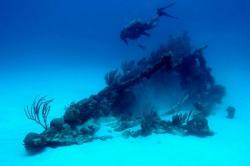
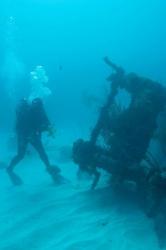 South Shore - This summer, the Marine Heritage section of the Department of Conservation Services will work to rescue artifacts from the shipwreck of the blockade runner, the Marie Celeste. Recent storms have exposed more of the ship’s bow, revealing its contents while at the same time placing the artifacts at risk. The Marie Celeste, also known as the Mary Celestia a Confederate paddle steamer sank in 1864 in mysterious circumstances while being piloted by John Virgin.
South Shore - This summer, the Marine Heritage section of the Department of Conservation Services will work to rescue artifacts from the shipwreck of the blockade runner, the Marie Celeste. Recent storms have exposed more of the ship’s bow, revealing its contents while at the same time placing the artifacts at risk. The Marie Celeste, also known as the Mary Celestia a Confederate paddle steamer sank in 1864 in mysterious circumstances while being piloted by John Virgin.
http://www.royalgazette.com/article/20110513/NEWS07/705139933/-1/news
- CHINE – Zhoukoudian - The protective excavation of the No.1 site at the Zhoukoudian Peking Man Site was launched on May 16. This is the largest protective excavation since the Zhoukoudian Peking Man Site was first excavated in 1921. In order to eliminate safety hazards, such as sliding, holes, cracks and dangerous rocks in the sections of cave deposits that may have been caused by the long-term weathering of natural forces, the Zhoukoudian Peking Man Site Administration and the Institute of Vertebrate Paleontology and Paleoanthropology under the Chinese Academy of Sciences jointly launched a protective excavation of the western section at the No.1 site (Ape-man Cave). The No.1 site of the Zhoukoudian Peking Man Site is located on the northeastern slope of Longgu Mountain and is the most important site of the Zhoukoudian Peking Man relics. A total of more than 200 "Peking Man" fossils were excavated at this site since 1921. Currently, the Ape-man Cave still holds one-third of the original accumulations.
http://english.peopledaily.com.cn/90001/90782/7384379.html
- ROYAUME-UNI - 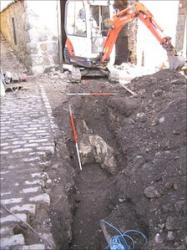
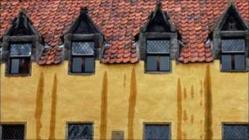 Culross - One of Fife's most historic buildings could have had an east wing, according to new evidence uncovered by archaeologists. Foundations of previously unrecorded buildings, including a series of foundations and paving, suggest Culross Palace may have had an east wing. Culross Palace is an early 17th century merchant's house in Culross, Fife. The palace, or "Great Lodging", was constructed by 1611 by Sir George Bruce, the Laird of Carnock. Sir George was a successful merchant who had a flourishing trade with other Forth ports, the Low Countries and the Baltic countries. He had interests in coal mining and salt production, and is credited with sinking the world's first coal mine to extend under the sea. Many of the materials used in the construction of the palace were obtained during the course of Sir George's foreign trade.
Culross - One of Fife's most historic buildings could have had an east wing, according to new evidence uncovered by archaeologists. Foundations of previously unrecorded buildings, including a series of foundations and paving, suggest Culross Palace may have had an east wing. Culross Palace is an early 17th century merchant's house in Culross, Fife. The palace, or "Great Lodging", was constructed by 1611 by Sir George Bruce, the Laird of Carnock. Sir George was a successful merchant who had a flourishing trade with other Forth ports, the Low Countries and the Baltic countries. He had interests in coal mining and salt production, and is credited with sinking the world's first coal mine to extend under the sea. Many of the materials used in the construction of the palace were obtained during the course of Sir George's foreign trade.
http://www.bbc.co.uk/news/uk-scotland-edinburgh-east-fife-13439279
- PHILIPPINES – Boljoon - Our joint University of San Carlos (USC) and National Museum team of archaeologists arrived here yesterday to begin the sixth phase of excavations.We are back, this time with funding from the Sumitomo Foundation of Japan, which has provided a generous facility to look for more Japanese ceramics dating to the 1600s and publish the results in both scholarly and popular format. In 2009, you see, the fifth round of excavations recovered for the first time in Philippine history not one but three intact and complete ceramics that were clearly made in the Hizen kilns in what is now Saga prefecture in Japan. How these ceramics reached Boljoon, south Cebu, when they would have been destined for the lucrative markets in Mexico and the New World during the Manila Galleon Trade, needs to be explained fully. For now, archaeologists are here to look for more evidence of these ceramics because before Boljoon, only a few broken fragments were recovered in the Philippines, on a site in Intramuros where such ceramic wares were loaded onto galleons bound for Acapulco, Mexico. Those very ceramics we unearthed in 2009 here in Boljoon are now on display at the Boljoon Parish Museum. And next week an expert from Arita Folklore and History Museum, Dr. Takenori Nogami, who identified these ceramics himself, will join the dig. It was Dr. Ken, as he is fondly called, who also identified the shards from Intramuros (recovered during an excavation conducted by the National Museum). Today, we begin opening a unit we closed off in 2009 because we ran out of time and funds. We unearthed only the feet of the burial. We hope that during this current dig, the entire burial will be fully exposed as a good beginning to what we hope will be another promising first for Boljoon. More on this next week.
http://newsinfo.inquirer.net/7121/the-search-is-on